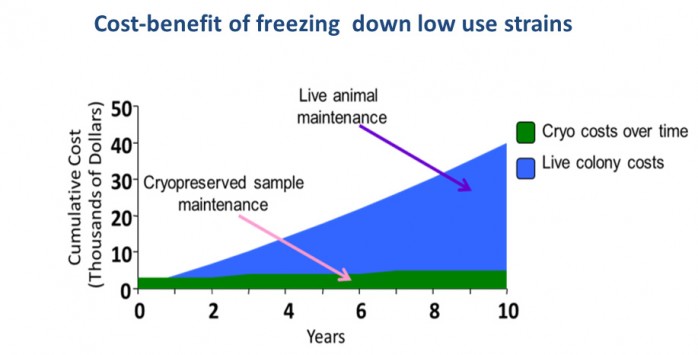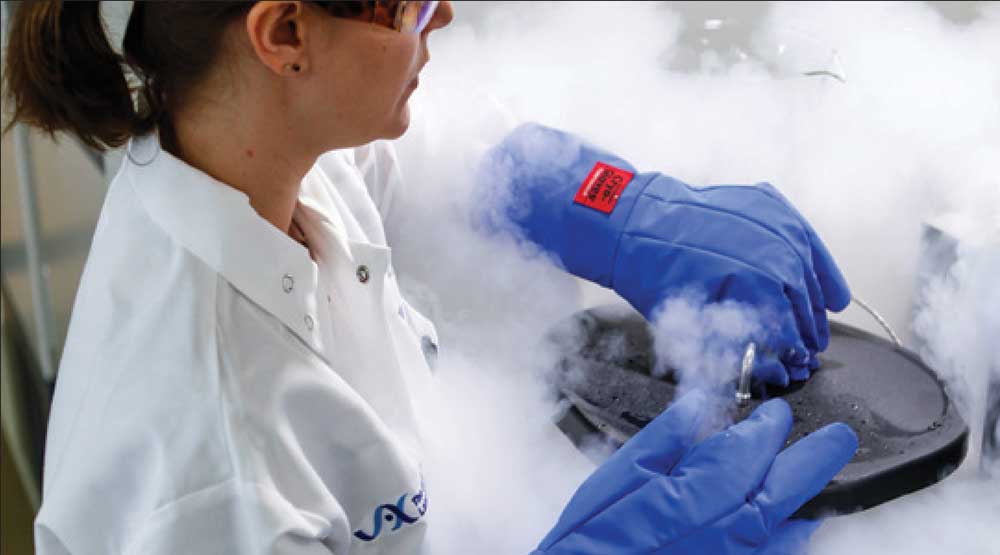Controlling costs: Freezing strains not actively enrolled on research studies
Mouse researchers know that maintaining research models as live colonies is financially draining and carries constant potential risks, including disastrous loss due to disease outbreaks, breeding cessation, and facility failures. During the past 6 years, stringent research budgets have driven many institutions to promote cryostorage of research strains to reduce the population pressures on existing vivarium space and the need to construct new facilities.
Cryopreservation is a very powerful colony management tool that both protects strains from loss and simultaneously ensures that they remain available upon demand (via cryorecovery) for:
- Collaborations
- Re-initiation of projects
- Re-evaluation of data
- Fulfilling the NIH mandate to share new model organisms with the research community
The trend has been to reduce operating costs further by outsourcing strain backup and distribution, relieving investigators and core facilities of the burden of maintaining and cryorecovering unique research strains in genetic backgrounds that are known to respond less robustly to the cryostorage-reanimation process (Wiles et al. 2010).

Figure 1. Cost-benefit of cryopreserving versus maintaining live colonies of low use research strains.
Cryopreservation costs are typically recovered through cage-cost savings in just months. Colony costs depend on the number of boxes maintained and the cage cost/day. The cost to maintain a heterozygous colony that requires frequent genotyping ranges from a few thousand dollars, to over $10,000 per year.
As shown in the graph above, even in a scenario with low per diem rates, the cumulative cost of maintaining a colony increases significantly faster than the cumulative cost of cryopreserving a strain. Note that this strategy is cost effective even if periodic recoveries and subsequent short-term maintenance of a live colony are needed (e.g. between years 2-3 and 6-7, as illustrated).
Research-based insights into affordable management of mouse models
Over the past decade scientists at JAX have conducted extensive research in mouse strain cryopreservation techniques to establish optimal cryoprotectant solutions, and optimal cooling and warming protocols for preserving research mice on diverse genetic backgrounds (Byers et al. 2006, Ostermeier et al. 2008, Wiles et al. 2010).
These developments are the bases for affordable conservation and colony management practices implemented at JAX, as well as our ability to reliably distribute more than 7,000 genetically modified mouse lines around the world. Using our pioneering cryopreservation techniques, JAX has cryopreserved more than 4 million embryos from 20,000 strains, and we routinely recover successfully more than 2,000 strains a year that ship globally. Moreover, JAX has helped hundreds institutions do large scale cryopreservation of hundreds of their idle research strains.
Outsource cryopreservation services?
You may ask yourself: Should I try cryopreserving my mice myself, or outsource it? If biopreservation is not done correctly, a strain may be lost. Cryopreservation using suboptimal conditions can result in:
- Extensive damage to cell membranes
- Alteration of the functional and metabolic status of the cells and mitochondria
- Increase in DNA single-strand breaks
Keep in mind that the extent of this damage can vary by the methods employed (Kopeika et al. 2014) and may be genetic background-sensitive. Generally speaking, the expense of training, operating and maintaining in-house cryopreservation facilities is not cost-effective for most small or medium size academic or biotech organizations. JAX® has the whole range of Cryopreservation and Recovery Services to fit different research needs.
Something to think about next time you scrutinize where your hard won research dollars are going.
